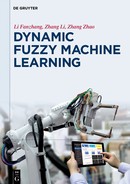Unexpected text node: ' r '
where, (r↼ij,r⇀ij)=(R↼,R⇀)((x↼i,xi⇀),(y↼j,y⇀j))(i≤n,j≤m).
Obviously, (L↼,L⇀)-type DF matrix is (L↼,L⇀)-type DF relations, and DF matrix is DF relations.
Definition 8.13 Assume (R↼,R⇀) is type DF matrix, and (R↼,R⇀)=(r↼ij,rij⇀)n×m(i≤n,j≤m), if it exits (L↼,L⇀)-type DF matrix Unexpected text node: ' Q ' let satisfy Unexpected text node: ' Q ' is regular, Unexpected text node: ' Q ' is the generalized (L↼,L⇀)-type DF matrix of (R↼,R⇀).
If we further have (Q↼,Q⇀)∘(R↼,R⇀)∘(Q↼,Q⇀)=(Q↼,Q⇀), is the T inverse matrix of (R↼,R⇀).
Theorem 8.10 Assume (Q↼,Q⇀) is the generalized (L↼,L⇀)-type DF inverse matrix of (R↼,R⇀),then(S↼,S⇀)=(Q↼,Q⇀)∘(R↼,R⇀)∘(Q↼,Q⇀) is T inverse matrix of (R↼,R⇀), where L is distributive lattice.
Proof: According to Definition 8.13, we can prove (R↼,R⇀)∘(S↼,S⇀)∘(R↼,R⇀)=(R↼,R⇀)∘(Q↼,Q⇀)∘(R↼,R⇀)∘(Q↼,Q⇀)∘(R↼,R⇀)=(R↼,R⇀)∘(Q↼,Q⇀)∘(R↼,R⇀)=(R↼,R⇀). Corollaries, (S↼,S⇀)∘(R↼,R⇀)∘(S↼,S⇀)=(Q↼,Q⇀)∘(R↼,R⇀)∘(Q↼,Q⇀)∘(R↼,R⇀)∘(Q↼,Q⇀)∘(R↼,R⇀)∘(Q↼,Q⇀)=(Q↼,Q⇀)∘(R↼,R⇀)∘(Q↼,Q⇀)=(S↼,S⇀)
[Prove up].
Theorem 8.11 Assume that (R↼,R⇀) is DF matrix, then the necessary and sufficient condition of (R↼,R⇀) is regular is (R←,R→)∘(X←,X→)∘(R←,R→)=(R←,R→), where, (X←,X→) is the maximum generalized DF inverse matrix of (R↼,R⇀). Namely, if (R←,R→)∘(Q←,Q→)∘(R←,R→)=(R←,R→), then we must have (Q←,Q→)⊂(X←,X→).
Proof: Sufficiency is obvious, and the necessity is presented as follows. Assume (R↼,R⇀) is regular, then it exits (Q←,Q→); let satisfy (R←,R→)∘(Q←,Q→)∘(R←,R→)=(R←,R→).
Therefore,
Unexpected text node: ' r '
Namely,

Thus, for ∀k≤n,e≤m, we have ((r←ie,r→ie)∧(q←ek,q→ek)∧(r←kj,r→kj))≤rij(i≤n,j≤m). We hence have
((r←ie,r←ie)Λ(r←kj,r←kj))≤(r←ij,r←ij)⇒0≤(q←ek,q→ek)≤1;((r←ie,r←ie)Λ(r←kj,r←kj))> (r←ij,r←ij)⇒0≤(q←ek,q→ek)≤(r←ij,r←ij).
Then, Unexpected text node: ' r '(x↼ek,x⇀ek),Namely,(Q↼,Q⇀)⊂(X↼,X⇀) and (R↼,R⇀)∘(Q←,Q→)∘(R←,R→)⊂(R←,R→)∘(X←,X→)∘(R←,R→).
Assume (U←,U→)=(R←,R→)∘(X←,X→)∘(R←,R→), then
uij=∨k=1n∨e=1m((r←ie,r←ie)Λ(x→ek,x←ek)Λ(x→ke,x←ke))(i≤n,j≤m).
We can prove uij ≤ n, ≤ j ≤ m).
In fact, when uij≤rij(i≤n,j≤m). we have ((r←ie,r→ie)∧(r←ei,rej→))≤(r←ij,r→ij),((r←ie,r→ie)∧(x←ik,x→ik)∧ Therefore, (u←ij,u→ij)≤(r←ij,rij→)(i≤n,i≤m), namely, (R←,R→)∘(X←,X→)∘ (R←,R→)⊂(R←,R→)=(R←,R→)∘(Q←,Q→)∘(R←,R→); hence, (R←,R→)∘(X←,X→)∘(R←,R→)=(R←,R→).
If (Q′←−,Q′−→) satisfies (R←,R→)∘(Q′←−,Q′−→)∘(R←,R→)=(R←,R→) and (R←,R→)⊂(X←,X→), then (X←,X→) is the maximum generalized DF inverse matrix of (R←,R→)∘(Q←,Q→)∘(R←,R→)=(R←,R→).
[Prove up].
8.3Dynamic fuzzy logic
8.3.1Dynamic fuzzy Boolean variable
(1) Dynamic fuzzy number Boolean variable
DF number Boolean variable is the Boolean variable in [0, 1] × [←, →]. While “0” means false, we note that 0← or 0→ 0 means DF false. While “1” means true, we note that 1← or 1→ means DF true. We use a number which is greater than the number “0” and less than “1” to indicate a Boolean variable between DF true and false. For example (0.7←−,0.7−→), real number 0.7 has two trends: it can tend to “0” and but also to “1.”
(2) Dynamic fuzzy interval Boolean variable
Definition 8.14 Assume that any dynamic fuzzy number (a←,a→) and (b←,b→) satisfies (0←,0→)≤(a←,a→)≤(b←,b→)≤(1←,1→), and any dynamic fuzzy number (p←,p→) satisfies (0←,0→)≤(p←,p→)≤(1←,1→), then we name that [(a←,a→),(b←,b→)] as interval Boolean variable, [(a←,a→),(b←,b→)]/(p←,p→) as DF interval Boolean variable.
Interval Boolean variable [(a←,a→),(b←,b→)] means a value between (a←,a→) and (b←,b→). DF interval Boolean variable [(a←,a→),(b←,b→)]/(p←,p→) means we use (p←,p→) to describe the possibility of a real number locates in [(a←,a→),(b←,b→)].
(3) Dynamic fuzzy linguistic Boolean variable
Using natural language to describe the true degree is one kind of the most intuitive way. This so-called “true and false” is actually a group of natural language vocabulary expressed, such as using the phrase TV = {the most true, quite true, very true, almost true,} to describe “degree of true and false”. Although these words in different natural languages, which are sometimes difficult to distinguish the boundaries, appear different representations, their meaning can be correctly understood and will not cause misunderstanding.
In fact, according to the specific requirements of the problem, we can also assume the external variable of language set, that is, DF linguistic Boolean variable, as long as their semantics can be correctly understood, and will not cause misunderstanding.
8.3.2DF proposition logic formation
In the real word, there are often the following sentences.
(1)It becomes fine after the rain.
(2)She is almost as beautiful as her mother.
In these sentences, “almost as beautiful as” and “becomes fine” have the character of dynamic fuzzy.
Definition 8.15 In a declarative sentence with the character of dynamic fuzzy, we note that as DFL proposition. This is expressed with capital letters A, B, C, . . .. For a DF proposition, there is no absolute true or false. We can only ask how about the dynamic fuzzy true or false degree.
Definition 8.16 We use a DF number (a←,a→)∈[0,1]×[←,→] to represent and measure the truth or falsehood of a DF proposition. We call that degree of truth and falsehood. We usually use lower case letters (a←,a→),(b←,b→),(c←,c→),... to express this.
![]()
